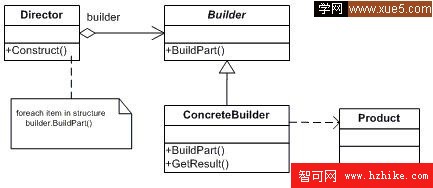
建造者(Builder)角色:給出一個抽象接口,以規范產品對象的各個組成成分的建造。一般而言,此接口獨立於應用程序的商業邏輯。模式中直接創建產品對象的是具體建造者(ConcreteBuilder)角色。具體建造者類必須實現這個接口所要求的方法:一個是建造方法,另一個是結果返還方法。
具體建造者(Concrete Builder)角色:擔任這個角色的是於應用程序緊密相關的類,它們在應用程序調用下創建產品實例。這個角色主要完成的任務包括:實現Builder角色提供的接口,一步一步完成創建產品實例的過程;在建造過程完成後,提供產品的實例。
產品(Product)角色:產品便是建造中的復雜對象。
以以.Net Framework 2.0 System.Text. StringBuilder為例
System.Text. StringBuilder
Code
public sealed class StringBuilder : ISerializable
{
//
internal IntPtr m_currentThread = Thread.InternalGetCurrentThread();
internal int m_MaxCapacity = 0;
internal volatile String m_StringValue = null;
//
public StringBuilder() : this(DefaultCapacity)
{
}
//
public StringBuilder Append(String value)
{
//If the value being added is null, eat the null
//and return.
if (value == null)
{
return this;
}
IntPtr tid;
// hand inlining of GetThreadSafeString
String currentString = m_StringValue;
tid = Thread.InternalGetCurrentThread();
if (m_currentThread != tid)
currentString = String.GetStringForStringBuilder(currentString, currentString.Capacity);
int currentLength = currentString.Length;
int requiredLength = currentLength + value.Length;
if (NeedsAllocation(currentString, requiredLength))
{
String newString = GetNewString(currentString, requiredLength);
newString.AppendInPlace(value, currentLength);
ReplaceString(tid, newString);
}
else
{
currentString.AppendInPlace(value, currentLength);
ReplaceString(tid, currentString);
}
return this;
}
//
public StringBuilder Append(int value)
{
return Append(value.ToString(CultureInfo.CurrentCulture));
}
//
public override String ToString()
{
//
// We assume that their read of m_currentThread will always occur after read of m_StringValue.
// If these reads get re-ordered then it is possible to get a currentString owned by some other
// (mutating) thread and yet think, according to currentThread, that such was not the case.
// This is acheived by marking m_StringValue as volatile.
//
String currentString = m_StringValue;
IntPtr currentThread = m_currentThread; //
// Note calling ToString the second time or from a different thread will cause allocation of a new string.
// If we do not make a copy if currentThread is IntPtr.Zero, we will have following race:
//
// (1) Thread T1 completes a mutation of the string and will become the owner.
// T1 then starts another mutation Operation and
// A thread interleaving happens at this point.
// (2) Thread T2 starts a ToString Operation. T2 reads m_StringValue into its local currentString variable.
// A thread interleaving happens at this point.
// (3) Thread T3 finshes a mutation of the string in the StringBuilder , performing the ReplaceString call.
// Thread T3 then starts a ToString Operation. Assuming the string is not wasting excessive space,
// T3 will proceeds to call ClearPostNullChar, registers NOBODY as the owner, and returns the string.
// A thread interleaving happens at this point.
// (4) Thread T2 resumes execution. T2 reads m_currentThread and sees that NOBODY is the registered owner
// Assuming its currentString is not wasting excessive space, T2 will return the same string that thread T1 is
// in the middle of mutating.
//
if (currentThread != Thread.InternalGetCurrentThread())
{
return String.InternalCopy(currentString);
}
if ((2 * currentString.Length) < currentString.ArrayLength)
{
return String.InternalCopy(currentString);
}
currentString.ClearPostNullChar();
m_currentThread = IntPtr.Zero;
return currentString;
}
}
System.String
Code
public sealed class String : IComparable, ICloneable, IConvertible, IEnumerable
{
//
// Creates a new string with the characters copIEd in from ptr. If
// ptr is null, a string initialized to ";<;No Object>;"; (i.e.,
// String.NullString) is created.
//
[CLSCompliant(false), MethodImplAttribute(MethodImplOptions.InternalCall)]
unsafe public extern String(char* value);
[CLSCompliant(false), MethodImplAttribute(MethodImplOptions.InternalCall)]
unsafe public extern String(char* value, int startIndex, int length);
[CLSCompliant(false), MethodImplAttribute(MethodImplOptions.InternalCall)]
unsafe public extern String(sbyte* value);
[CLSCompliant(false), MethodImplAttribute(MethodImplOptions.InternalCall)]
unsafe public extern String(sbyte* value, int startIndex, int length);
[CLSCompliant(false), MethodImplAttribute(MethodImplOptions.InternalCall)]
unsafe public extern String(sbyte* value, int startIndex, int length, Encoding enc);
//
// Creates a new string from the characters in a subarray. The new string
will
// be created from the characters in value between startIndex and
// startIndex + length - 1.
//
[MethodImplAttribute(MethodImplOptions.InternalCall)]
public extern String(char[] value, int startIndex, int length);
// Creates a new string from the characters in a subarray. The new string will be
// created from the characters in value.
//
[MethodImplAttribute(MethodImplOptions.InternalCall)]
public extern String(char[] value);
//
internal unsafe void AppendInPlace(String value, int currentLength)
{
int count = value.Length;
int newLength = currentLength + count;
//
fixed (char* dest = &this.m_firstChar)
{
fixed (char* src = &value.m_firstChar)
{
wstrcpy(dest + currentLength, src, count);
}
dest[newLength] = '';
}
this.m_stringLength = newLength;
}
//
}
調用代碼
Code
public class ClIEnt
{
public static void Main()
{
StringBuilder sb = new StringBuilder();
sb.Append("Hello");
sb.Append(" World");
sb.Append("!");
String s = sb.ToString();
Console.Write(s);
Console.ReadLine();
}
}
由於String類型代表的是一個不可變的字符串,所以BCL提供了另一個名為System.Text.StringBuilder的類型,它允許我們有效的對字符串的字符執行動態操作,以創建一個String。
從邏輯上說,StringBuilder對象中包含一個字段,它引用由Char結構構成的一個數組。StringBuilder的成員允許我們操作這個字符,有效的縮減字符串的大小或者更改字符串中的字符。如果字符串變大,超過已經分配的字符的大小,StringBuilder就會自動的分配一個全新的、更大的數組,並開始使用新的數組,前一個數組會被垃圾回收器回收。用StringBuilder對象構建好字符串之後,為了將StringBuilder的字符“轉換”成一個String,只需調用StringBuilder的ToString方法,在內部,該方法只是返回對StringBuilder內部維護的字符串的字段的一個引用,執行效率非常快,因為它不需要進行字符數組復制。
C#中volatile 關鍵字指示一個字段可以由多個同時執行的線程修改。聲明為 volatile 的字段不受編譯器優化(假定由單個線程訪問)的限制。這樣可以確保該字段在任何時間呈現的都是最新的值。可變關鍵字僅可應用於類或結構字段。不能將局部變量聲明為 volatile。
StringBuilder既是具體建造者(Builder)又是指導者(Director),最終生成一個復雜的String對象作為產品(Product)。在具體建造者只有一個的情況下,如果抽象建造者角色已經被省略掉,那麼還可以省略掉指導者角色。讓Builder角色自己扮演指導者與建造者雙重角色。
以下情況應當使用建造者模式:
1.需要生成的產品對象有復雜的內部結構。
2.需要生成的產品對象的屬性相互依賴,建造者模式可以強迫生成順序。
3.在對象創建過程中會使用到系統中的一些其它對象,這些對象在產品對
象的創建過程中不易得到。